Key takeaways:
- Pollinator gardens attract and support essential species like bees and butterflies, enhancing biodiversity and ecosystem health.
- Diversity in plant selection, especially native species, is crucial for attracting a variety of pollinators and ensuring continuous food supply throughout the growing season.
- Creating a habitat involves providing shelter, water sources, and maintaining natural areas to support pollinator well-being.
- Minimizing pesticide use fosters a balanced ecosystem, allowing both pollinators and beneficial insects to thrive.
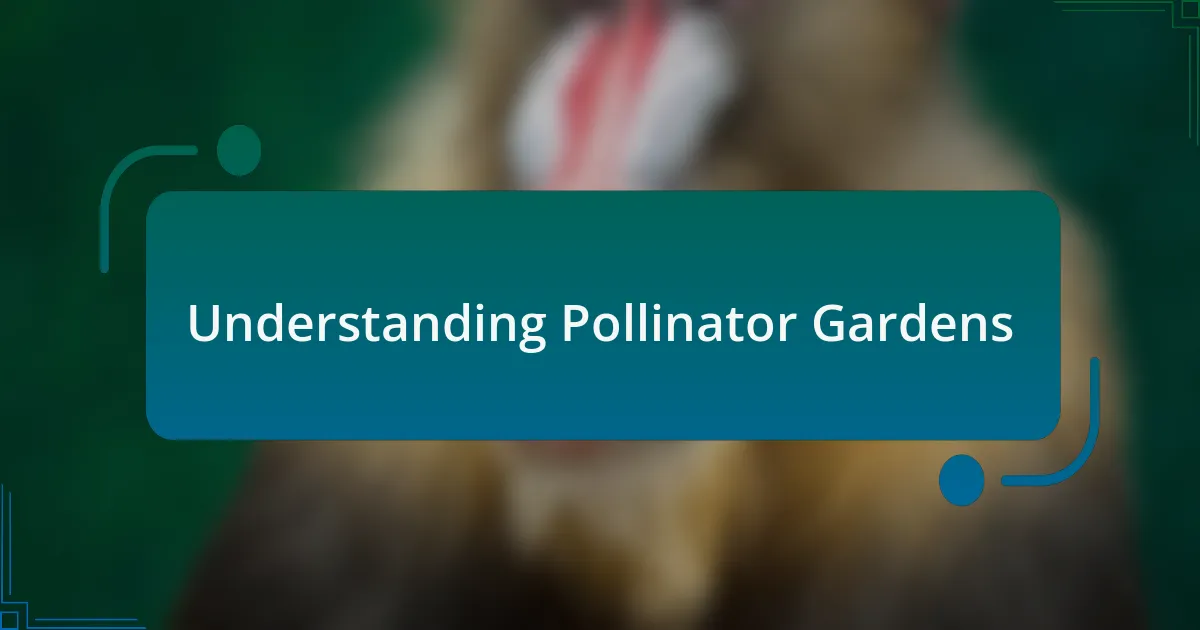
Understanding Pollinator Gardens
Pollinator gardens are specifically designed to attract and support pollinators like bees, butterflies, and hummingbirds. I remember the first time I sat in my garden, surrounded by busy bees flitting from flower to flower. It struck me how crucial these little creatures are, not just for our plants, but for our entire ecosystem.
Creating a pollinator garden offers a vibrant display of flowers, yet it goes beyond aesthetics. I often find myself marveling at the diversity of insects that visit my garden—a bustling network of life right outside my window. Have you ever stopped to think about how much richer our environment becomes when we invite these tiny workers into our space?
To attract a variety of pollinators, it’s essential to choose a mix of native plants that bloom at different times throughout the growing season. I made the mistake of planting only a few species, and I quickly realized that diversity brings in more pollinators. Imagine watching a garden bursting to life with color and movement, reminding us of the interconnectedness of all living things.

Importance of Pollinators
Pollinators play an essential role in our food production. I remember harvesting fruits and vegetables from my garden, feeling a sense of pride in knowing that the hard work of bees was part of that equation. Without these tiny workers, many plants wouldn’t reproduce, leading to a significant decline in the availability of some of our favorite foods. Have you ever thought about how many meals depend on pollination?
The beauty of pollinators extends far beyond the garden; they contribute to the health of entire ecosystems. On a quiet afternoon, while observing butterflies dancing among the blossoms, it struck me how they help maintain biodiversity. Each species plays its part, and without pollinators, we risk unbalancing these delicate systems. Imagine the ripple effects in nature when we lose such key players.
Moreover, pollinators are indicators of environmental health. I often find myself pondering their presence in my garden—is it a good sign? When they’re thriving, it generally means our environment is in good shape. This connection reminds me of our responsibility to protect these vital creatures, creating spaces where they can flourish. How can we ignore their significance when they serve as a reflection of our planet’s well-being?
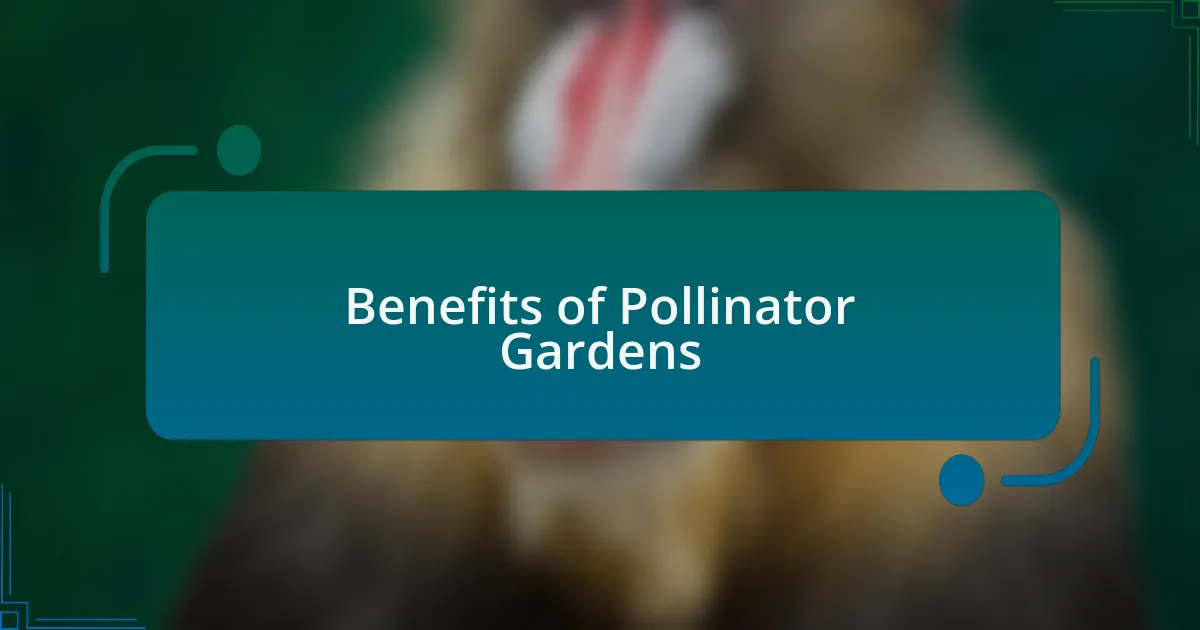
Benefits of Pollinator Gardens
Pollinator gardens provide an inviting oasis for essential species like bees, butterflies, and birds. I vividly recall standing in my garden, watching as a swarm of bees danced from flower to flower, and I felt a sense of joy knowing that I was supporting their habitats. These gardens create a safe space for these creatures, allowing them to thrive and, in turn, enhance the overall productivity of my garden. Have you ever noticed how much livelier your garden becomes with just a few thoughtful plant choices?
Another great benefit is the increase in biodiversity. When I planted diverse blooms, I was amazed to see a variety of insects coming to visit. Each species contributes to the ecosystem in its unique way, leading to healthier plants and a more resilient environment. It got me thinking—if I’ve seen this transformation in my backyard, what could we achieve on a larger scale with community pollinator gardens?
On a personal note, pollinator gardens also elevate our daily experiences. I enjoy sipping my morning coffee while being serenaded by the buzz of bees and the flutter of wings. It’s a reminder of the interconnectedness of life and our role in preserving these ecosystems. How often do we allow ourselves to pause and appreciate the simple pleasures that come from nurturing our environment?
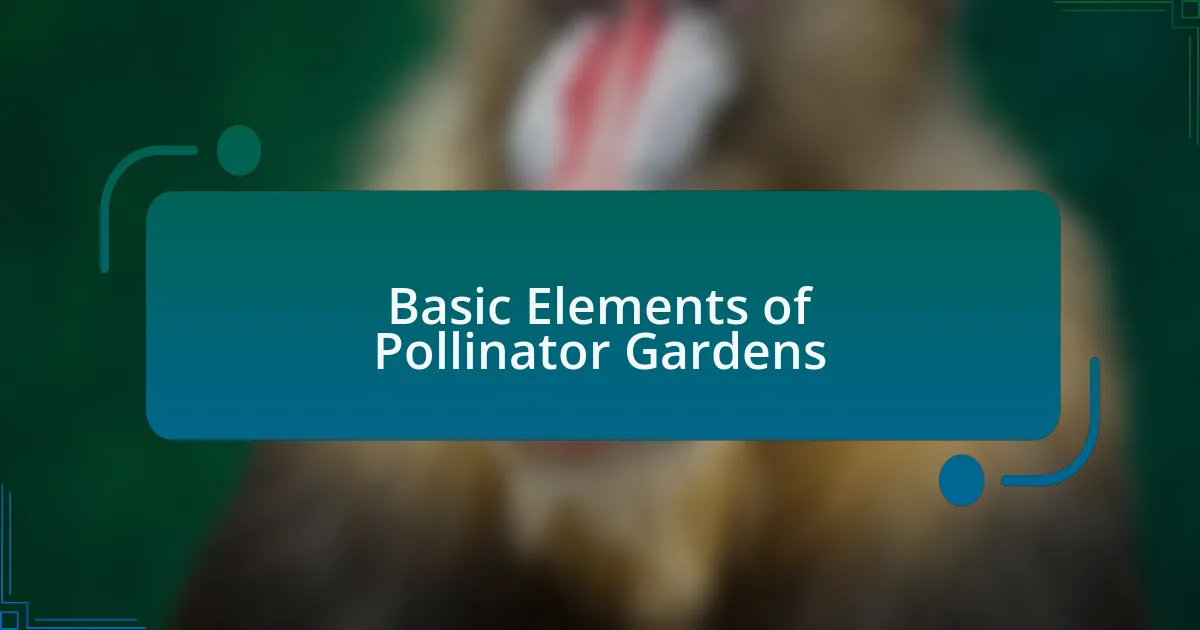
Basic Elements of Pollinator Gardens
Creating a successful pollinator garden starts with selecting the right plants. I remember how exciting it was to explore local nurseries and discover native plants that would thrive in my area. It’s fascinating to realize that choosing plants native to your region not only supports local pollinators but also simplifies gardening by reducing the need for irrigation and pesticides.
Another crucial element is ensuring a continuous bloom throughout the growing season. I always mark my calendar for when different flowers come into bloom. This helps to provide a steady source of food for pollinators. Have you ever noticed how certain plants seem to attract specific insects? In my experience, this diversity of blooms turns my garden into a lively buffet, welcoming a parade of bees and butterflies on warm days.
Lastly, the layout and structure of the garden matter greatly. I’ve found it helpful to create clusters of plants rather than single rows. This setup encourages pollinators to spend more time in one area. It’s like hosting a dinner party—don’t we all enjoy mingling in a cozy space where everything we love is accessible? By making my garden welcoming, I’ve seen not only an increase in pollinator activity, but a more vibrant and dynamic space for myself and my family.
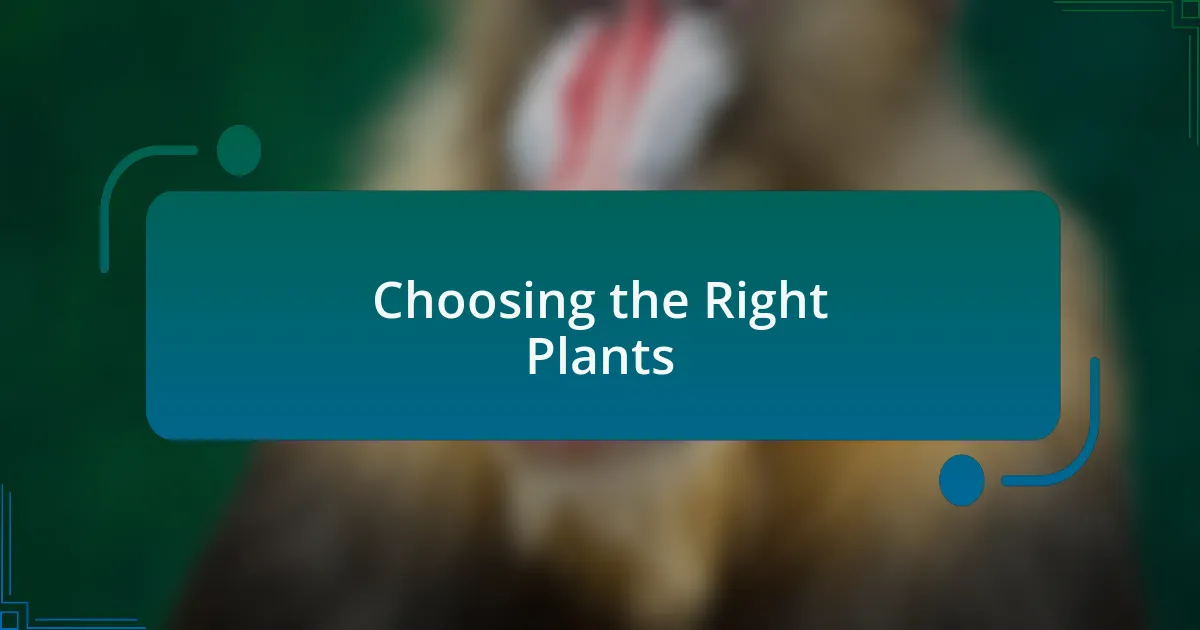
Choosing the Right Plants
When it comes to selecting plants, I often consider the lifecycle needs of various pollinators. For example, adding milkweed has not only brought monarch butterflies into my garden but also taught me the importance of planting host plants. Have you ever watched a caterpillar transform? It’s a reminder of how vital these plants are for nurturing the next generation of pollinators.
I’ve also learned that color can be a powerful attractor. In my garden, I love mixing bright purples, yellows, and whites because they stand out and catch the attention of wandering bees. It’s like creating a canvas where every flower adds a stroke of beauty—don’t you think vibrant gardens instill joy in those who view them?
Lastly, don’t shy away from incorporating herbs like lavender or borage. I love the way they not only enhance my cooking but also draw in bees and other beneficial insects. Have you ever noticed how these plants seem to create a buzz in my garden? They add depth and aroma, making the space not just a feast for the eyes but a delight for the senses.
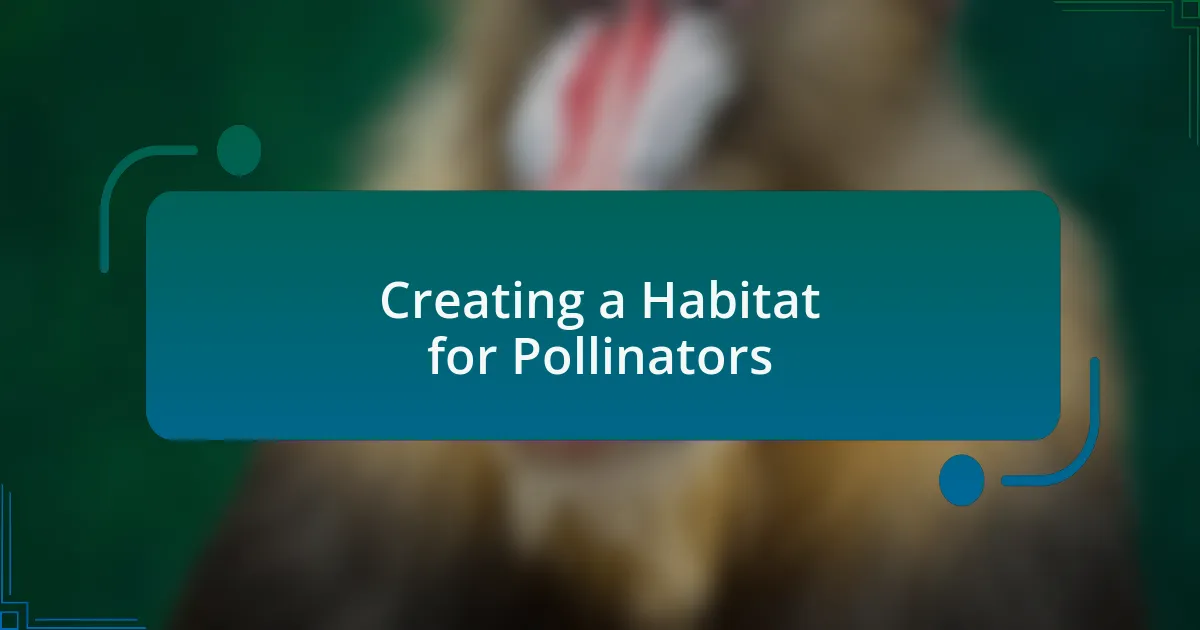
Creating a Habitat for Pollinators
Creating a Habitat for Pollinators
I can’t stress enough the importance of providing shelter for pollinators. In my own garden, I’ve added log piles and stones, which not only enhance the landscape but also create cozy nooks for solitary bees and other critters. Have you ever spotted a bush or corner bustling with life? It’s fascinating to see how such simple features invite so much biodiversity.
Water sources are another essential element I’ve prioritized. Early in the mornings, I often see butterflies and bees sipping from shallow dishes filled with pebbles and water. It’s heartwarming to watch these small creatures hydrate after a night of rest, and it reminds me how vital these little details can be in supporting their well-being.
Lastly, I’ve learned that maintaining a natural, untamed section of my yard can work wonders. Leaving some native grasses and wildflowers to grow freely has attracted not only pollinators but also other beneficial wildlife. Have you ever noticed how a little chaos in the garden can turn into a thriving ecosystem? It’s incredible to watch nature take its course while fostering an inviting habitat.
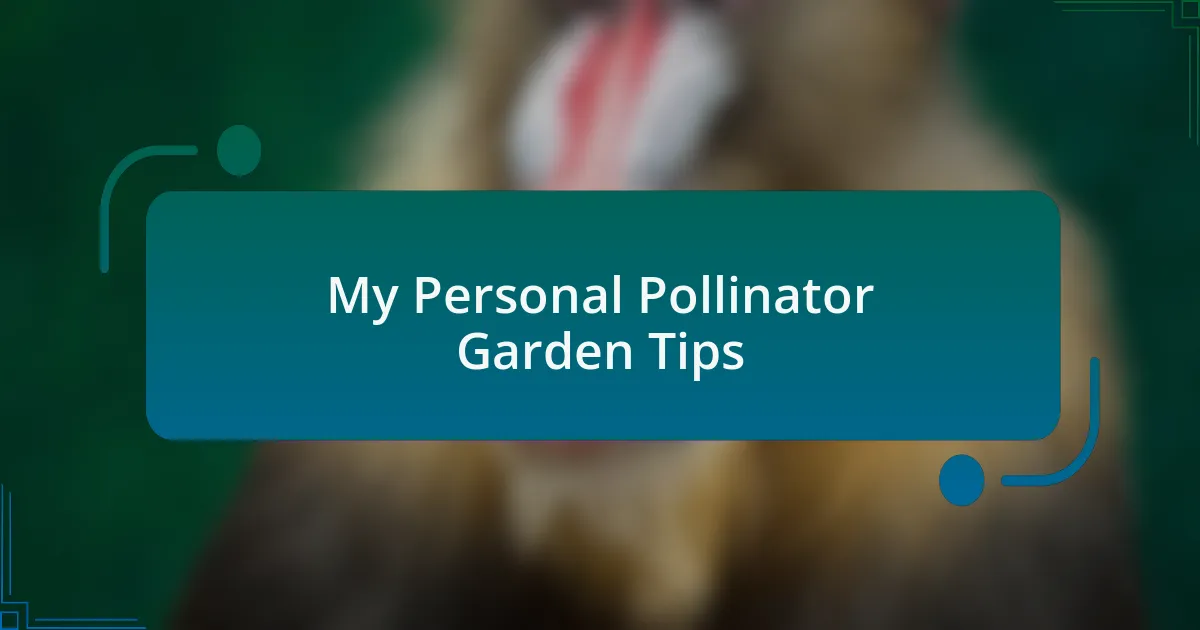
My Personal Pollinator Garden Tips
When it comes to choosing plants for my pollinator garden, I’ve found that selecting a variety of native species is crucial. In my experience, native plants not only require less maintenance but also thrive in our local environment, making them perfect for attracting pollinators. Have you ever been amazed at how certain flowers seem to come alive with buzzing activity? I often sit back with a cup of tea, watching bees dance from bloom to bloom, and it fills me with joy to see the garden bustling with life.
One tip that truly transformed my garden is planting in clusters rather than scattering flowers. I learned this when I noticed that my single poppies seemed to attract fewer visitors. So, I grouped them together, and suddenly, the fluttering of butterflies and bees was a regular sight. Isn’t it fascinating how such a simple change can result in a vibrant gathering of pollinators? It’s moments like these that deepen my appreciation for the interconnections in nature.
Lastly, I make it a point to minimize pesticide use in my garden. While I used to think that any pest was a foe, I’ve come to understand that many of them play a role in the ecosystem. By adopting a more hands-off approach, I’ve welcomed more beneficial insects into my garden, which has reduced pests naturally. Have you ever felt a sense of pride watching nature take charge? It’s rewarding to know that my garden is a balanced environment where pollinators can thrive without the harm of chemicals.